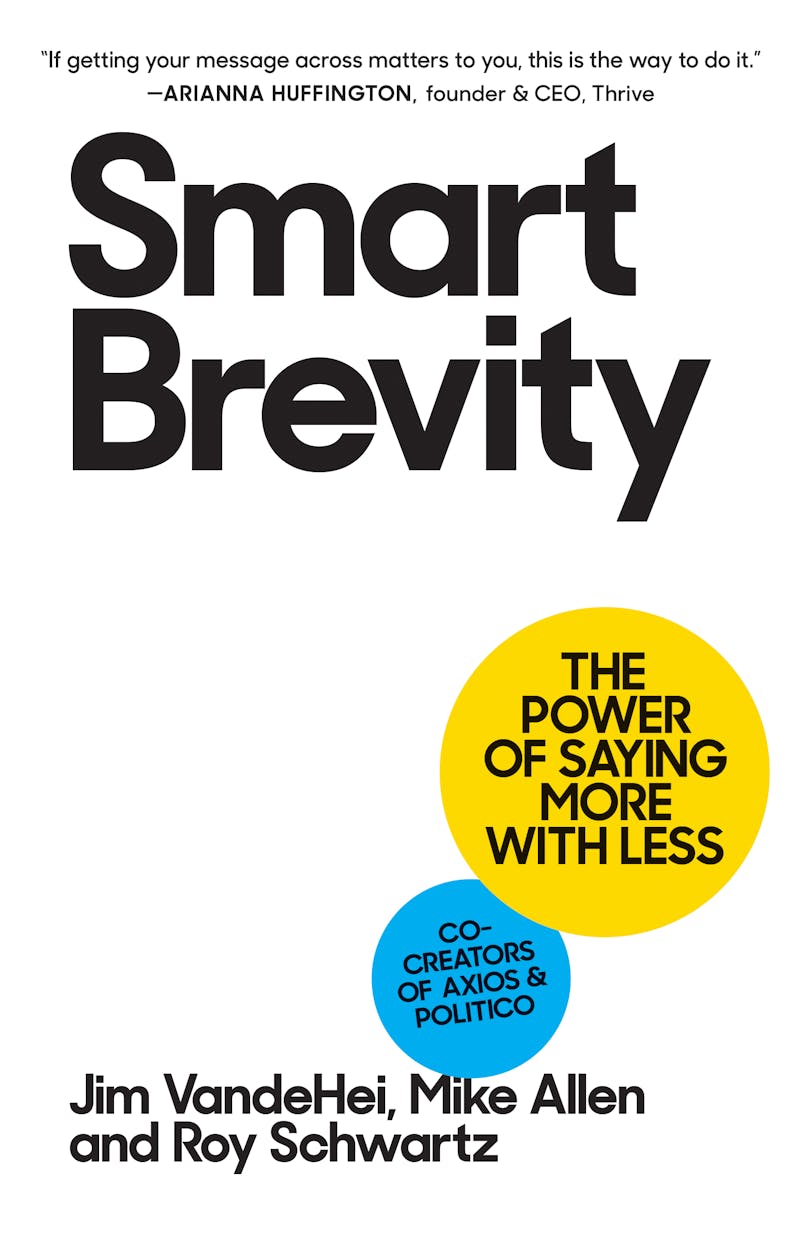Smart Brevity is a bad book.
WHY IT MATTERS:

Jim VandeHei, Mike Allen, and Roy Schwartz have failed to translate the power of the successful rhetorical style pioneered in their political website, Axios, into a book. Smart Brevity, as its title implies, argues for a writing style that is short and punchy and trims the fat from most corporate, academic, and personal communication. The book advocates short (no sentence longer than six words!), declarative judgments like the sentence that begins this review—a sentence that, while meeting the authors’ stylistic criteria, is not entirely fair to the book or to you, the reader of this review.
Go a little deeper, and you can see what happens when you privilege one goal—saving time—over all others: a book by veteran political writers that manages to deliberately efface the essential politics inherent in rhetorical style.
THE BIG PICTURE:
We’re now checking our phones something like 344 times a day, once every four minutes. Keeping a reader’s attention is harder than ever, and VandeHei, Allen, and Schwartz know it. Rather than fight the trend of online distraction, Smart Brevity’s authors embrace it: Today’s writing, they argue, must be fast, clipped, cut to the bone, with every sentence tightly packed with information and designed to grab eyeballs. With an “if you can’t beat ’em, join ’em” ethos, Smart Brevity argues that there’s no way to overcome the distraction economy, so one must fine tune one’s writing to compete with TikTok and Twitter.
Its recommendations follow the trajectory of the authors’ careers: from traditional print journalism like The Washington Post to the founding of Politico, with its quick-hit dopamine stories modeled on ESPN’s SportsCenter, to Axios, which brought an even briefer aesthetic to daily briefings. The book is designed less to be read than it is to be consumed: Like a fast-food value meal, it’s tightly engineered to deliver content in a digestible package for the on-the-go knowledge worker. Every chapter leads off with a word count and the number of minutes required to read it, white space complements bolded text and bullet points, and paragraphs rarely break two sentences. The headers that define Axios’s style (“Be Smart,” “Why It Matters,” “Go Deeper,” and so forth) abound. Em dashes—which, Emily Dickinson will tell you, are the punctuation marks of impatient breathlessness—dominate.
In this age of social media, you must be ruthless in competing for readers’ attention; Smart Brevity thus argues for headlines with no more than six words, with the most important point upfront. Use short, declarative statements with only new or surprising content—everything else gets cut. The writing of Smart Brevity is refreshingly taut and punchy; most of the sentences are finely crafted, short, and to the point, and rip across the page. It feels at times like you’re reading the outline of a book rather than the book itself, but nevertheless your eyes glide effortlessly from one page to the next, bearing out the success of its strategy.
Smart Brevity has its share of helpful tips.
“Talk to someone else (or yourself—no one will know) about the point you want to make,” the authors advise. “It’ll be clearer, more interesting and more urgent than anything you’d ever come up with if you sat down to ‘write.’ Then write it down. Write that one thing you want the reader, viewer or listener to remember if it’s all they take away. Write that before doing anything else.”
They repeatedly stress this point, and it’s a good one: All of us are generally more effective communicators in person than on the page, and using social cues and conversational instinct to refine written communication can help clarify your own argument and allow you to workshop the most effective and direct way to communicate it. They also note that setting a time before a meeting can help maximize the work accomplished and that an email will have more impact if you place the main news or ask in the first line. In the chapter on inclusive writing, they highlight that their tactic of cutting unnecessary words can lead to cutting descriptors that may subtly or unintentionally reinforce racial stereotypes, and they suggest that simply browsing the style guide of the National Association of Black Journalists will give writers who aren’t Black more insight into how to better use language.
Oddly, Smart Brevity does not feel brief. Chapter 2 (14 pages, 2,195 words, an eight-minute read) is titled “Smart Brevity, Explained,” but fewer than 300 words over two pages are spent on “Smart Brevity’s Core 4,” the basics of what the style looks like. The rest of the chapter contains sentences that are stubbornly abstract (“Smart Brevity is a new way to think about creating, sharing, and consuming information in our cluttered, clanging digital world”), describing why normal writing is bad and what people are actually looking for. In a book that advises “skip the anecdotes,” there are anecdotes about how Smart Brevity was born and how corporate clients began approaching the authors begging them to teach Axios’s style to their employees. There are examples that demonstrate what Smart Brevity looks like but almost none of the “explanation” promised by the title.
In fact, most of the first few chapters is concerned not with what Smart Brevity is but what Smart Brevity can do for you. It’s a series of claims about how much better your life will be if you adopt this style (“Smart Brevity will make you more efficient and effective at work, a more forceful communicator and more useful and memorable on social media. Your voice and words will pop and echo like never before”) matched with real-world examples of people whose lives have benefited from Smart Brevity’s techniques. (Smart Brevity “has helped transform how hundreds of operations such as the NFL; big companies such as Lyft; politicians such as the Austin, Texas, mayor; school systems and Realtors connect with staff, constituents, and buyers.”) This buildup of promises and testimonials, long before we get to the actual product, is the realm of carnival barkers, late-night infomercials, and multilevel marketing schemes. It’s not particularly brief, and it’s not for smart people.
For a book about how to distill your message into the tightest format, Smart Brevity is filled with redundancies. We are told again and again to put the most important point up front, instructed multiple times that headlines should have six words or less, and told ad infinitum that readers are too busy today to read inessential writing. Sometimes the book literally repeats itself: Chapter 12 explains that “part of the ‘smart’ in Smart Brevity lies in the selection,” while Chapter 13 explains that “part of the ‘smart’ in Smart Brevity is in selection.”
Nor, honestly, does Smart Brevity seem to care about being smart. There’s very little in here that advises how to maintain depth or nuance as one cuts prose to the bone. Nearly every chapter repeats the same advice: Condense your writing, make it punchy, use bullet points and emojis to grab attention. The content—and specifically, how to maintain smartness as you trim your prose—is mostly absent from the book. The one repeated nod to being “smart” is always to pick information that’s most vital: “Make sure every item is essential, increasing the chances that readers will pay attention to the few things that really matter.” But what qualifies as “essential” will always be left up to the reader, and by the book’s end it’s not at all clear how this method can possibly preserve anything like the complexity required to process deep, conceptual problems.
This is a book about boiling your content down to the fewest words possible, but the actual content is entirely up to you. If the authors are constantly exhorting you to “Be Smart!” it’s because they themselves cannot teach you smartness in Smart Brevity. You either are or you aren’t.
But most importantly, Smart Brevity itself isn’t all that smart. Chapter after chapter offers writing and style tips, but hardly any of it is new. “Use Active Verbs,” they instruct, explaining: “An active verb brings action to your writing—it’s someone doing something: Roy races Miatas.” Not only is “active verbs bring action” a mushy tautology, it’s the kind of advice we’ve been seeing for over a century; at least there was some novelty in the sentiment when Strunk and White advised that “the active voice is usually more direct and vigorous than the passive” in The Elements of Style in 1918.
What updates from Strunk and White a reader does find here mainly include advice to use bullet points and emojis. Otherwise, there’s very little stylistic guidance in Smart Brevity that isn’t already contained in these two sentences from William Zinsser’s perennially popular 1976 book On Writing Well:
The secret to good writing is to strip every sentence to its cleanest components. Every word that serves no function, every long word that could be a short word, every adverb that carries the same meaning that’s already in the verb, every passive construction that leaves the reader unsure of who is doing what—these are the thousand and one adulterants that weaken the strength of a sentence.
VandeHei, Allen, and Schwartz have given us a book that, like weight loss books, presents an age-old problem as though no one’s ever thought to confront it before, then offers a series of clichéd solutions as some sort of novel life hack. (Left unresolved is the question: If readers’ attentions have diminished so radically with the advent of social media, why are the best writing techniques for the twenty-first century nearly identical to those of the pre-internet age?)
As with all these past style guides, of course, there is a lack of discussion as to why one would use the cleanest, most stripped-down and monosyllabic choices available—an incuriosity that reveals a great deal. VandeHei, Allen, and Schwartz at one point throw out an example about how to ask for a raise: It’s bad to say, “I have been here three years and work very hard and have this new house and car I need to finance and want to discuss, um, the possibility of increasing my salary if you are willing”; much better is simply, “I know my value and want to discuss a raise.” This, frankly, is advice by white men for white men. Any woman in a professional context—and certainly any woman of color—knows full well that directly and bluntly asking to be properly valued for her competence runs the risk of being labeled “bossy,” “bitchy,” “difficult,” “angry,” etc. The equivocations, soft-pedaling, and code-switching you’re obliged to have at the ready if you aren’t a white cis man are tools of self-preservation and navigation in unfair power structures.
BE SMART:
Discussions of style never exist outside of discussions of power.
GO DEEPER:
It’s not that I don’t share Smart Brevity’s disdain for logorrhea and interminable writing. Like anyone else, I’ve had to sift through overlong emails from bosses that say little at great length. The insular gibberish that is much of contemporary academic writing, with its useless neologisms and excessive syntax designed to drive out casual readers, deeply offends me. I, like everyone I know, am drowning in too much prose, and the dream of One Simple Trick that could scythe through it all, reducing language to its essence, is endlessly appealing. As much as I love complex, convoluted writing, I appreciate the pleasures of speedy prose, and, like many terminally online social media users interested in politics, I’ve been reading Axios for years.
When Axios’s founders were still in school, the Italian writer Italo Calvino named “quickness” as one of the six defining traits of the coming twenty-first century. In his 1985 essay (posthumously published in Six Memos for the New Millennium), Calvino quotes Giacomo Leopardi, who wrote in 1821:
Speed and conciseness of style please us because they present the mind with a rush of ideas that are simultaneous, or that follow each other so quickly they seem simultaneous, and set the mind afloat on such an abundance of thoughts or images or spiritual feelings that either it cannot embrace them all, each one fully, or it has no time to be idle and empty of feelings. The power of poetic style, which is largely the same thing as rapidity, is pleasing for these effects alone and consists in nothing else.
Echoing this, Calvino adds: “Mental speed is valuable for its own sake, for the pleasure it gives to anyone who is sensitive to such a thing, and not for the practical use that can be made of it. A swift piece of reasoning is not necessarily better than a long-pondered one. Far from it. But it communicates something special that is derived simply from its very swiftness.”
The fundamental misunderstanding around the kind of brevity Axios and similar sites offer is not that it’s smarter; it’s that it’s pleasurable. I can’t help but agree with Leopardi and Calvino that there’s a lightness and joy in reading that kind of svelte, swift prose. It is not necessarily more or less pleasurable than reading the sentences of Virginia Woolf or Henry James, though, in today’s distraction economy, it’s a more readily available pleasure.
But language will always be fundamentally political, and no demand for a rhetorical mode is ever neutral. As the National Association of Black Journalists Style Guide explains, our responsibility is to use words “correctly and appropriately,” not just quickly. Words arrive before us fraught with intended and unintended meanings. Syntax conveys not just the literal meanings of one’s words but education and intended audience. Responsible writers weigh the countervailing and sometimes contradictory impulses in writing constantly, deciding what’s best rather than what’s simply fast. Ultimately, “smart” writing is that which conveys a strong moral clarity: a sense of audience that is inclusive, a mitigation of the unintended effects of language, and an ability to state one’s position clearly without resorting to euphemism or obfuscation.
This could have simply been a book about brevity. But instead, VandeHei, Allen, and Schwartz chose to argue that speed implies a moral clarity—that the writing style is not just faster, it’s smarter. In doing so, Smart Brevity presents an aesthetic as an ethic.






